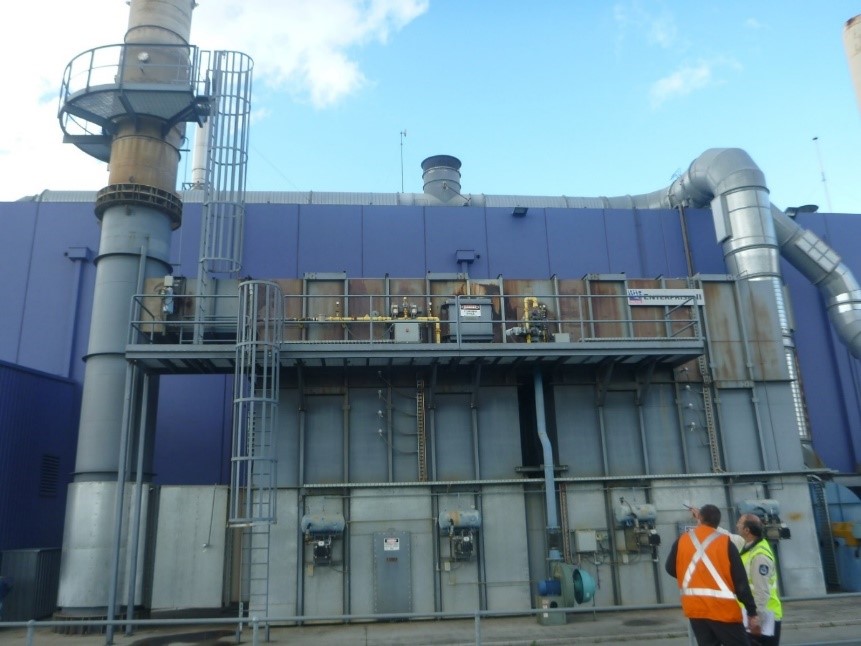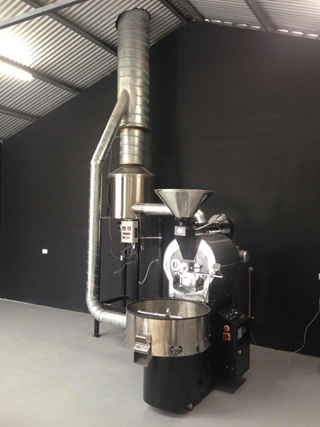This guidance sheet is part of a series of guidance sheets. It should be read with our odour guidance for businesses.
On this page
Description
Thermal oxidisers, also known as incinerators or afterburners, break down odour and hazardous gases at high temperatures to produce carbon dioxide and water. There are several types of thermal oxidisers which all work in slightly different ways but produce the same result.
To assess whether thermal oxidiser technology is an appropriate odour treatment method, contact a suitably qualified professional. For advice on choosing a suitably qualified professional please see EPA’s information about engaging a consultant.
Examples of variations in size, from large scale industrial (image 1) to at home coffee roasters (image 2). Images provided by Chris Bydder.


Type of control
Physical.
When you would use this
If your business or site produces gases that contain hydrocarbon-based odours, then a thermal oxidiser could be appropriate.
Suitable for: generally thermal oxidisers work best on hydrocarbon based hazardous air pollutants (HAPs), or volatile organic compounds (VOCs).
Industries that would use this: industries that commonly use thermal oxidisers include fibreglass manufacturing, printing, coffee roasting, coating and laminating, polystyrene manufacturing and recycling, or metal finishing. This is not an exhaustive list of industries that could implement a thermal oxidiser.
Details and considerations
There are three main factors to consider when designing a thermal oxidiser:
- Temperature needs to be high enough to ignite the waste gases. This will generally be above 650°C.
- Residence time, which is how long the gas needs to remain in the thermal oxidiser to ensure complete combustion. This is typically resolved by correct sizing of equipment to suit the optimal airflow.
- Turbulence, the amount of oxygen that will need to be mixed with the gas during combustion to ensure VOCs and HAPs are sufficiently broken down.
There are many types of thermal oxidiser to consider.
Afterburner (direct fired thermal oxidiser)
This is the most common type of thermal oxidiser. The source gas is pumped into the burner that operates at 980°C – 1200°C, with airflow rates between 0.24m3 and 24m3 per second. These are best used when there is a very high concentration of VOCs or HAPs.
Regenerative thermal oxidiser (RTO)
RTOs use a ceramic bed that is heated by the previous oxidisation cycle to preheat source gases, partially oxidising them. These gases then enter the main burner area that operates at 760°C – 820°C, but can reach up to 1100°C with airflow rates between 2.4m3 and 240m3 per second. RTOs are very popular because they are versatile and efficient.
Flameless thermal oxidiser (FTO)
Unlike other thermal oxidisers, source gases, oxygen, and fuel are premixed before being fed through a preheated inert ceramic media bed. Oxidisation occurs in these systems through the transfer of heat from the ceramic media bed. The oxidisation reaction produces heat which heats the ceramic media bed. FTOs are considered very safe and reliable, however, they are not applicable to all circumstances. This is why it is important to understand the gas your business or site produces before selecting the type of thermal oxidiser to implement.
Catalytic oxidiser
Catalytic oxidisers are similar to standard thermal oxidisers, although they use a catalyst to increase the rate of oxidisation. Using a catalyst allows the oxidisation reaction to occur at a lower temperature, generally around 340°C – 540°C. This means that the operating costs could be lowered with a more efficient system. It is important to note that a catalytic oxidiser will not be appropriate in all circumstances.
Read more
Worksafe Australia NOHSC: 3008 (1995) – Guidance Note on the Interpretation of Exposure Standards for Atmospheric Contaminants in the Occupational Environment.
This page was copied from EPA's old website. It was last updated on 25 June 2019.
Reviewed 1 October 2020



